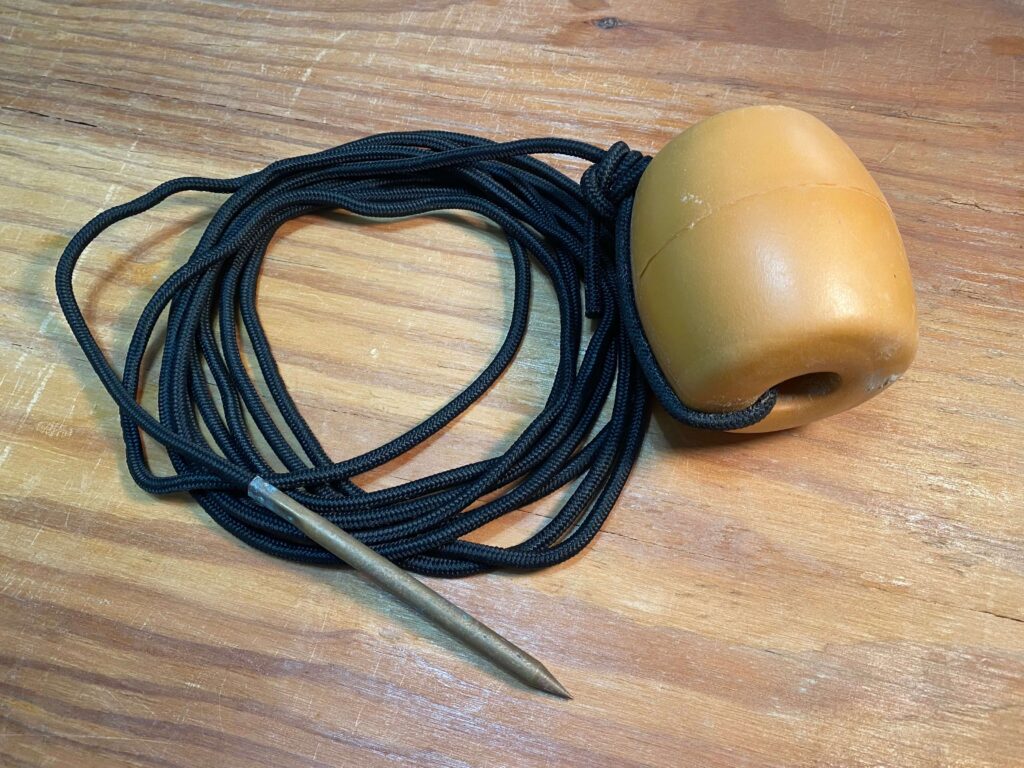I encourage you to try this challenge, it has worked well for me and has improved my catch rate significantly. Here’s the challenge: Leave your fish stringer at home. Don’t attach it to your wading belt, don’t put it in your kayak, and don’t keep it in your car. Leave it at home and forget about it.
What is a Fish Stringer?
If you are new to fishing and are wondering what a fish stringer is, it is this thing:

Sometimes simply called a “stringer”, it is used to hold your fish and keep them alive while you are out fishing. It is intended for fish that you plan to keep and eat (never for fish that you plan to release). For example, say you are out wadefishing, and you catch a keeper fish. You run the brass spike through the fish’s gills or through his bottom lip, then you keep pulling the rope until the fish is near the float end of the rope. You tie the spike end of the stringer to your belt, and the “strung fish” basically floats in the water, alive, until you can get him into a cooler. If you catch another fish, you just add him to the stringer using the same process.
Why You Should Leave Your Stringer At Home
Keeping fish to eat has been done literally since man has been around. For recreational fisherman, it is a sign of success. Nothing feels better to the fisherman’s ego than showing off a stringer of fish at a crowded fishing spot or fish cleaning table. One of my buddies used to say “if ya didn’t keep it, ya didn’t catch it”. And to be clear, there is nothing wrong with keeping fish if the law allows you to do it. I used to keep fish all the time, and still do occasionally. But, if you want to focus on improving your fishing skills, I recommend leaving the stringer at home on every one of your serious fishing trips. Take it with you only if fishing with friends and family, or when you are on a trip specifically to collect a few fish for the table. But otherwise, leave it. I have followed this philosophy for years now and it has made a tremendous difference in my catch rate, and has also simplified my fishing greatly.
Why? Because without the stringer, your mind is free to focus 100% on fishing, with zero pressure to catch something. Your mind will focus on the details that are important, instead of the irrelevant details of preserving fish. When a fishing trip is over, you will realize a new kind of fulfillment, gained from fishing for sport instead of for food or ego. You will appreciate what you caught, without having to take it home to prove something. But what if you catch the fish of a lifetime? Well, hopefully you have a camera to preserve that memory. If not, then that memory will exist with you and only with you.
Plus, there are some “cons” to carrying a stringer:
- It is one more piece of gear to remember (or forget).
- Your trip will end in disappointment if you don’t catch fish to put on your stringer, because the empty stringer tells your brain that “you failed”.
- If you string fish, you are now obligated to clean them and eat them when you get home. Cleaning fish is messy (although, it is fun) and requires extra effort when you get home and are tired.
- If you string a fish, you now have a fish that can spoil. You are on the clock to some degree. Sometimes it may be necessary to cut a trip short so that you can clean the fish and get them refrigerated. Or, maybe you decide to transfer the fish to a cooler so that you can keep fishing, but that requires an extra piece of gear (the cooler) and an extra hassle and expense to get the ice.
- Sometimes, you will catch a keeper fish fish at the beginning of your trip, so you string him up. Then you don’t catch anything else for the rest of the trip. I have actually experienced this many times, and so have my buddies. Now you’re stuck having to clean this one fish. As stated above, this requires extra effort when you get home and are tired…and you only get two fillets!
So, try leaving your stringer at home and see if your catch rate improves. Even if it doesn’t improve right away, at least you won’t be stuck cleaning one fish!
Have a reel good day,
– The Simple Fisherman
